Spinoza´s werk blijft beschouwd als tot de joodse literatuur behorend
Tot en met januari 2017 loopt in het Joods Historisch Museum de tentoonstelling "De glorie van het joodse boek,” waarop ook het Vaticaanse Ethica-manuscript te zien is. Een bewijs ervan hoe joden maar al te graag Spinoza in hun geschiedenis ingelijfd willen houden - waar ik geen enkele moeite mee heb, daarover geen misverstand: Spinoza 'is ook van hen.' Het blijkt ook uit het dit jaar verschenen boek:
 Adam Kirsch, The
People and the Books. 18 Classics of Jewish Literature. W. W. Norton &
Company, 2016 - books.google
Adam Kirsch, The
People and the Books. 18 Classics of Jewish Literature. W. W. Norton &
Company, 2016 - books.google
Hoofdstukken zijn gewijd aan de Bijbelboeken Deuteronomium en Esther, en verder aan werk van Philo van Alexandrië, Flavius Josephus, Pirkei Avot, Benjamin van Tudela, Yehuda Halevi, Moses Maimonides, de Zohar, Glückel van Hameln, Spinoza (de TTP, niet de Ethica), Solomon Maimon en Moses Mendelssohn, Nachman van Bratislava, Theodor Herzl en Sholem Aleichem.
Een kort review op Kirkus:
Poet and critic Kirsch (Director, Jewish Studies Master’s Program/Columbia
Univ.; Rocket and Lightship: Essays on Literature and Ideas, 2014,
etc.) takes a reflective look at what his Jewish religion has been and can be
via some of its greatest books. His ambitious survey spans more than 2,500
years and offers a “panoramic portrait of Jewish thought and experience.” The
books focus on four central topics: God, the Torah, the Land of Israel, and the
Jewish people. Kirsch begins pretty much at the beginning with the book of
Deuteronomy. Devoted to law and history, it’s concerned with the major subject
of the Israelites’ relationship to the Land of Israel. He next turns to the
book of Esther, which is best read as “historical fiction.” Kirsch is
fascinated with its “paradox of Jewish power in a condition of Diaspora.” Jump
ahead some 500 hundred years to the Jewish general captured by the Romans,
Flavius Josephus, and his The Jewish War, a firsthand account of
“perhaps the greatest calamity in Jewish history.” After an account of the Zohar,
a 2,400-page compendium that “enchants the universe like no other Jewish book,”
comes Glückel of Hameln’s transformative Tsenerene from the 1590s, “one
of the most popular Yiddish books of all time.” It did the most to “connect Jewish
women to Judaism’s traditional sources,” while her Memoirs is the first
autobiography by a Jewish woman. From the 1890s, Kirsch singles out the
visionary Viennese writer Theodor Herzl as one of the “most important figures
in Jewish history.” The Jewish State, a nonfiction pamphlet, “laid out a
detailed plan for the relocation of Europe’s Jews to Palestine,” while his
novel Old New Land helped to create Zionism. Kirsch ends his list in
1914 with the Tevye stories of Sholem Aleichem. Although a mere 120 pages long,
“no work of Yiddish literature has been more influential or more widely loved.”
[van hier]
De slotparagraaf van zijn hoofdstuk over de TTP luidt
"Considered as a Jewish book, too, the Theological-Political Treatise marks the beginning of a new era. As
we have seen, the questions Spinoza asked about Judaism and the Bible are
similar to the ones Maimonides had asked five hundred years earlier, and Philo
a thousand years before that. How to reconcile reason and faith, how to give
Jewish law meaning, how to read the Bible—these are not modern questions, but
ones that recur whenever Jews confront the philosophical tradition. What made
Spinoza's answer modern was that unlike all his predecessors, he did not
finally believe that reason and Judaism could be reconciled—and he decided in
favor of reason. Judaism as a religion, and Jewishness as an identity, appear
for the first time in Spinoza as unnecessary relics of the past, which the
enlightened individual must discard on the road to the secular and universal
society of the future. The great questions for Jews in the modern world would be
whether such a society could really exist and whether discarding Judaism was
too high a price to pay for admission."
Zie ook het uitgebreidere review van Dara Horn in The Wall Street Journal, 7 oktober 2016: "Adam Kirsch’s Anthology of Jewish Civilization’s Greatest Hits" [cf.]


Reacties
Nu ik het bovenstaande lees denk ik weer aan de donderdagavond van de zomerweek in Barchem van de VhS. Daar hadden twee sprekers van de week een levendige discussie over hetzelfde onderwerp betrekking hebbend op de toekomst van het Jodendom of het Jood zijn. Yoram Stein is ervan overtuigd dat Jodendom alleen toekomst heeft dankzij het bestaan van de orthodoxie terwijl Ronit Palache vindt dat het seculiere Jodendom heel goed kan blijven bestaan door bepaalde tradities in ere te houden zoals bepaalde Joodse feestdagen en simpoele dingen zoals kippesoep op vrijdagavond. Wat haar betreft is de orthodoxie of zijn andere religieeuze verschijningsvormen daar niet voor nodig. Het antwoord ligt in de toekomst.
Kees Bruijnes 09-10-2016 @ 10:22
Ik voel een zeker onbehagen bij dergelijke redenering.
Of: kan ik iemand tot de onzen rekenen nadat hij werd buiten gesmeten?
Hetzelfde onbehagen als wanneer men mij een “culturele christen” noemt. Ik ervaar dat als gebrek aan respect voor mijn huidige, atheïstische wereld- en levensvisie.
Zou Spinoza er niet net zo over denken, moest hij nog leven?
Budts 09-10-2016 @ 10:26
@ Kees,
Volgens mij bestaat er ook een seculier jodendom zonder viering van joodse feestdagen of eten van kippesoep op vrijdagavond, hetgeen zich dus verder van de traditie verwijdert dan wat je van Ronit Palache citeert.
@ Budts, Spinoza werd door het bestuur van de Amsterdamse Sefardische gemeente "buiten gesmeten", maar later door vele joden weer omarmd en beschouwd als "ook of weer van ons". Als dat maar niet exclusief bedoeld is. Als ze zijn ideeën waardevol vinden, denk ik niet dat Spinoza daar moeite mee zou hebben.
Stan Verdult 09-10-2016 @ 11:32
Ik wijs op een artikeltje: "Can Jews ever leave their Cult?" gisteren in "Media With Conscience"
http://www.mwcnews.net/focus/politics/61469-can-jews-ever-leave-their-cult.html
Stan Verdult 13-10-2016 @ 10:25